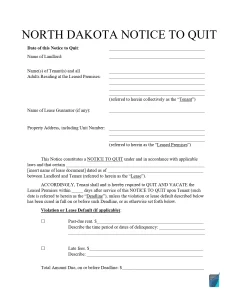North Dakota Eviction Notice Forms
The North Dakota eviction notice form is a formal tool for landlords to begin evicting a tenant from a rental unit. This form must be provided to the tenant to comply with state legal procedures and signal the beginning of the eviction process. The most common reasons for eviction in North Dakota are nonpayment of rent and violating the lease terms specified in the agreement.
Landlords must fill out this form precisely, as inaccuracies can delay the legal process or invalidate the eviction altogether. Therefore, it is advisable to use our printable eviction notice template and deliver it in strict compliance with North Dakota legal standards, thereby preserving the legitimacy of their case.

Build Your Document
Answer a few simple questions to make your document in minutes
Save and Print
Save progress and finish on any device, download and print anytime
Sign and Use
Your valid, lawyer-approved document is ready
North Dakota Eviction Laws
The North Dakota Century Code, Section 47-32-01, lays down explicit conditions under which a landlord can lawfully evict a tenant. These conditions include unlawful entry into or possession of property, using threats or violence to hold a property, and failure to vacate after the legal redemption period following a property sale.
Additionally, tenants who do not leave at the end of their lease term or fail to pay rent within three days of its due date are also subject to eviction. The permissible reasons for eviction in North Dakota include:
- Forceful or fraudulent property possession.
- Holding over a post-lease or post-redemption period.
- Significant lease agreement violations.
- Disturbing other tenants’ peaceful enjoyment of their premises.
The North Dakota laws are specific about the procedural requirements and timelines that must be followed to ensure a fair process. For example, landlords must provide a notice of intention to evict before proceeding with an eviction. This notice must be served between three and fifteen days before the summons date, as mandated by Section 47-32-02.
The North Dakota Century Code also stipulates that if a tenant cannot be found, the notice may be conspicuously posted on the premises, ensuring that the tenant has a chance to see it.
North Dakota Eviction Notice Laws Details
| Rent Grace Period | Not Mentioned |
| Notice of Non-Payment | 3 days |
| Notice of Non-Compliance | 3 days |
| State Laws | North Dakota Century Code, Chapter 47-32 |
Eviction Notice Types Used in North Dakota
North Dakota uses a variety of eviction notices, each tailored to specific circumstances outlined under state law.
3-Day Notice for Non-Payment of Rent
Under Section 47-32-01, landlords are entitled to issue a three-day notice for non-payment if rent is overdue by three days. This notice informs tenants that they must pay the overdue amount within three days or face potential eviction proceedings. This common eviction notice is used when tenants fail to meet their rental payment obligations.
3-Day Notice for Lease Violations
When tenants violate other lease terms, such as pet restrictions or unauthorized occupants, landlords can issue a notice specifying the breach’s nature. Failure to address the violation may lead to eviction proceedings. It’s important to note that according to Section 47-16-10 of the North Dakota Century Code, tenants (lessees) are responsible for repairing any damage to the rental property that results from their ordinary negligence.
30-Day Notice to Change Lease Terms
According to Section 47-16-07, landlords can alter the terms of a month-to-month lease by providing a written notice at least thirty days before the end of the month. This notice must clearly outline the new lease terms, rent adjustments, or other conditions that will take effect if the tenant chooses to stay beyond the notice period. This type of notice ensures tenants have sufficient time to consider the changes and decide whether to continue under the new terms or vacate the property.

Eviction Process in North Dakota
As a property owner in North Dakota, you may need to evict a tenant at some point. Below is a breakdown of the process into four steps.
Serving Eviction Notice
The first step in the eviction process involves the landlord issuing the appropriate notice to the tenant. The type of notice depends on the reason for eviction — whether it’s for non-payment of rent, lease violations, disturbance of peace, holding over past the lease term, or other reasons outlined in state law. This notice must be served according to legal requirements, giving the tenant a specific timeframe to respond or remedy the issue.
Wait Legally Required Period
After serving the eviction notice, the landlord must wait the legally required period, ranging from three to fifteen days, depending on the grounds for eviction. This waiting period allows the tenant to pay the due rent, correct the lease violation, or vacate the premises voluntarily. If the tenant addresses the issue within the specified period, eviction may be avoided.
File an Eviction Suit
If the tenant fails to comply with the eviction notice, the landlord’s next step is to file an eviction suit in the district court. This formal legal action requires submitting all relevant documentation, including proof of the issued eviction notice and evidence of the tenant’s failure to comply. The court will then schedule a hearing to review the case.
Court Hearing and Judgment
During the court hearing, both the landlord and the tenant can present their arguments. The landlord must demonstrate that the eviction notice was served correctly and that the grounds for eviction are valid. The tenant can present defenses or reasons for non-compliance.
If the court favors the landlord, it will issue a judgment for eviction, and the tenant will be legally required to leave the property within a specified period. If the tenant wins, they can remain on the property.

Use our document builder to customize any template on FormsPal to your preferences. Here is a number of some other widely-used North Dakota forms we provide.
Other Eviction Notice Forms by State